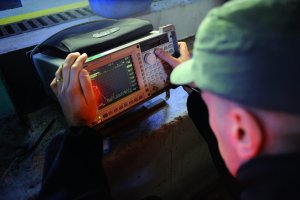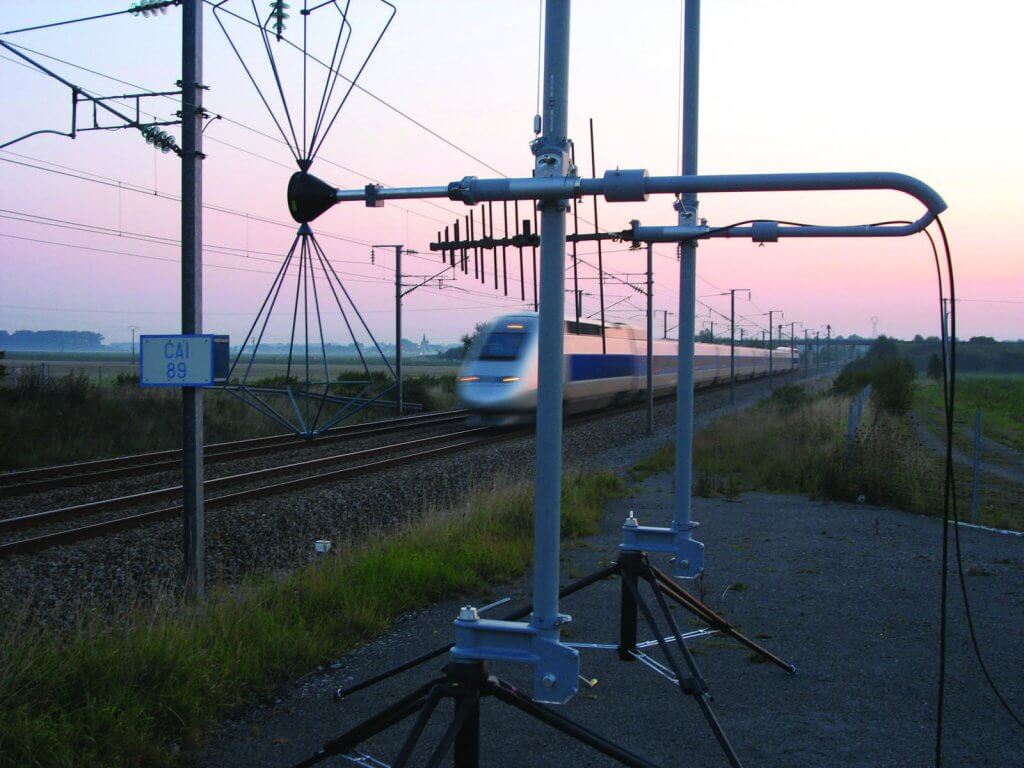Electromagnetic Compatibility – Rolling Stock
For type approval purposes, Eurailtest performs tests to verify the rolling stock electromagnetic compatibility and to check the compliance with EMC regulations.
Rolling stock electromagnetic compatibility
Checking that electrical signals generated by the train are compatible with the signalling, telecommunications, sub-stations and overhead lines for type approval purposes.
Tests objectives:
- Carry out dynamic tests, on trains or at standstill, during development or qualification of trains or components
- Establishing real time the current
– Generated by rolling stock
– That can interfere with signalling - Determine psophometric intensity
- Ensure coordination between traction units and fixed installations used for electric traction: power factor, power consumption, inrush current, peak voltage value, etc.
- Measure the effects of pollution of a brake shoe or material on a sample of wheel steel
Test facilities:
- Single-phase or DC power supply, high potential
- QMR-7
- Digital data acquisition systems (up to 1 MHz)
- Voltage and current sensors, singlephase and DC (up to 20 kHz)
Accreditations:
ISO/IEC 17025 awarded by COFRAC
Testing norms:
EN 50238 – Compatibility between rolling stock and train detection systems
EN 50121-3-1 – Electromagnetic compatibility – Part 3-1: Rolling stock – Train and complete vehicle
EN 50388 – Power supply and rolling stock – Technical criteria for the coordination between power supply (substation) and rolling stock to achieve interoperability
OP 09911 (SAM S 003) (IN 2724) – Compatibility between signalling systems and rolling stock
TS 50238-2 – Compatibility between rolling stock and train detection systems – Part 2: Compatibility with track circuits
Electromagnetic emissions
Check, for its type approval, that rolling stock complies with EMC regulations.
Tests objectives:
- Measure the electromagnetic field released by rolling stock into the outside environment (between 9 kHz and 1 GHz)
- Compare these levels with the limits set by standard EN 50121-3-1
Tests facilities:
- Spectrum analyzer
- Measuring receiver
- Loop antenna
- Biconical antenna
- Log periodic antenna
Accreditations:
ISO/IEC 17025 awarded by COFRAC
Testing norms:
EN 50121-3-1 – Electromagnetic compatibility – Part 3-1: Rolling stock – Train and complete vehicle
Electromagnetic emissions and human exposure
Check that electromagnetic fields generated by rolling stock, or railway premises, do not affect passengers or staff.
Tests objectives:
Characterize electromagnetic fields with regard to human exposure (1 Hz – 20 kHz)
- Measure electromagnetic field levels for all those parts of rolling stock accessible to passengers and employees
- Compare these levels with the limits set by European Directive 2013/35/ EU on worker exposure and European 1999/519/EC Recommendation on exposure of the general public to electromagnetic fields
Tests facilities:
- Magnetic field antennas
- Acquiris software
- Data acquisition board
- Electric field sensor
- Amperometric clamp
Testing norms:
EN 50500 – Measurement procedures of magnetic field levels generated by electronic and electrical apparatus in the railway environment with respect to human exposure

Electromagnetic interference
Checking that electrical equipment exposed to electromagnetic interference works properly for type approval purposes.
Tests objectives:
Ensure the proper functioning of onboard electrical equipment subject to electromagnetic interference
- Measure interference levels at the input and output of this equipment
- Protect electrical equipment with filtersé
Tests facilities:
- Anechoic chamber
- Solenoid
- Oscilloscope
- Spectrum analyzer
- Amperometric clamp (HF)
- Voltage probe
- Capacities, ferrites, filters, etc.
Testing norms:
EN 50121-4 – Electromagnetic compatibility – Part 4: Emission and immunity of the signalling and telecommunications apparatus

Please complete the contact form. One of our engineers will be in touch with you as soon as possible.
Go to formOur references
ALSTOM
ANSALDO BREDA
BOMBARDIER
RATP
SIEMENS
STADLER
CONVERGIE
SNCF




